AIRFRAMES, ENGINES AND SYSTEMS—PART I
- AIRFRAMES, ENGINES AND SYSTEMS—PART I
- Review
- Load and Load Factors
- Normal and Utility Categories
- Manoeuvring Speed and Gust Loads
- Logbooks and Inspections
- Certificates of Airworthiness
- Non-airworthiness
- Airworthiness Directives
- Service Bulletins
- Pilot Operating Handbooks
- Maintenance Release
- Elementary Work—Private Aircraft
- Elementary Work and Servicing—Commercial Aircraft
- References
Review
Definitions
There are two primary definitions to be aware of, the first being aircraft, which is any “machine capable of deriving support in the atmosphere from the reactions of the air.”
By comparison, the more specific category of aeroplane denotes any “power-driven heavier-than-air aircraft, deriving its lift in flight from aerodynamic reactions on surfaces that remain fixed under given conditions of flight.”
A final commonly used term is airframe, which is the aeroplane structure, excluding instruments and engine.
Parts of an Aeroplane
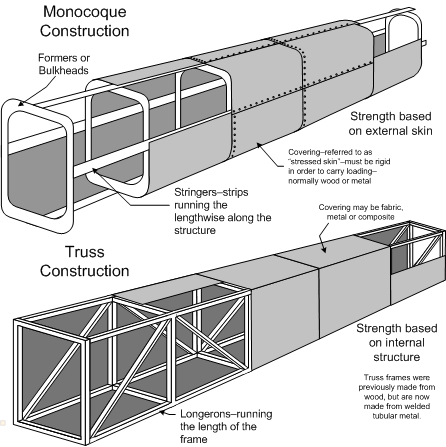
The fuselage denotes the central body of the aeroplane where passengers and cargo are housed.
Two types of fuselage construction exist, the first referred to as truss construction, which consists of longerons (tubes running length-wise) that are braced by beams to form a truss. The second is monocoque construction, which entails formers or bulkheads, joined by stringers (strips running length-wise), and surrounded by a stressed skin. The stressed skin is designed to be load-bearing, and it is this feature which differentiates it from traditional truss construction. As part of pilot pre-flight inspection, examination of stressed skin provides indication of the structural soundness of the fuselage.
The wing is the primary source of aerodynamic lift; the wing also houses fuel tanks. The main structural and load-bearing component of the wing is the spar that extends from wing tip to wing root, where it is attached to the fuselage.
Differentiation is made between wings with one spar—monospar—and wings with multiple spars—multispar.
With respect to internal structure, wing loading is transmitted to the spar by way of ribs, which extend from the leading to trailing edge, intersecting the spar.
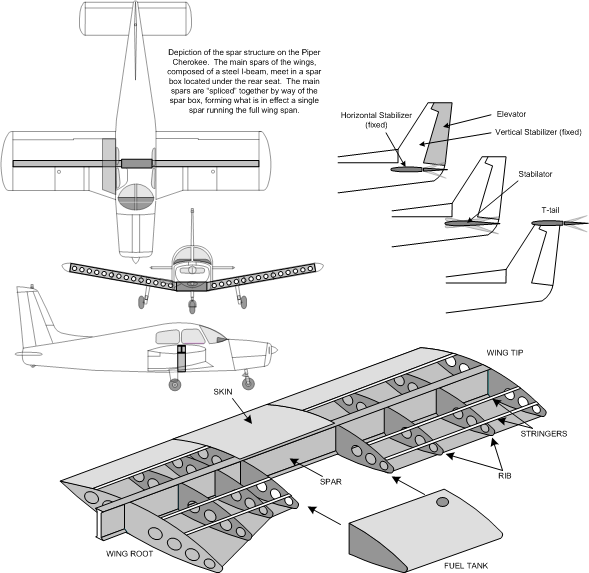
Two types of wing designs are distinguished: wings that are externally braced to the fuselage by struts, and wings lacking struts. Wings without struts are referred to as cantilever wings.
The tail, also referred to as the empennage, provides pitch (nose-up and nose-down) control, as well as yaw control (nose-left and nose-right). The tail also provides longitudinal stability (keeping the tail behind the head).
The tail consists of two parts, the horizontal stabilizer, and vertical fin; the elevator control surface is attached to the horizontal stabilizer (allowing pitch control), and the rudder control surface is attached to the vertical fin (allowing yaw control).
With respect to the horizontal stabilizer and the attached elevator, a second design, referred to as a stabilator, allows the pilot to control pitch by moving the entire horizontal surface.
Propulsion systems on aircraft include three categories: internal combustion engines, jet and turbine engines, and turboprops.
The engine is draped in a cowling to reduce drag and control air-cooling; additionally, the engine is separated from the remaining airframe, including fuel storage areas, by a firewall. The “vital actions” of the pilot in response to an engine fire (in accordance with the Pilot Operating Handbook) always entails closing cabin heat and window defrosting—if these actions are not done, the fire may spread past the firewall through these openings.
There are four types of undercarriage (landing gear): split axle, tripod, single-leaf cantilever, or single strut (see From the Ground Up).
A more fundamental variation in undercarriage is conventional and tricycle gear—the former having a tail wheel, and the latter having a nose wheel.
While conventional gear provides greater manoeuvrability, there are the risks of the aircraft performing a “nose-over,” or “ground looping” (tail moving sideways out of control). Conventional gear also presents decreased visibility during aircraft taxi and takeoff.
In contrast, tricycle gear provides increased control in cross-wind takeoffs and landings; but the design also has ground hazards such as wheelbarrowing on the nose, and porpoising. Tricycle gear provides increased drag (slowing the aircraft down), is more expensive to maintain, and is not as strong as conventional gear.
Load and Load Factors
Pilots must be extremely conscious of structural load and load factors.
A load factor is simply a weight ratio of the dead load (aircraft on the ramp) to the live load (in motion). On the ramp, without motion, the aircraft weighs 1 times its gravity weight—say 2000 lbs. This changes, however, whenever the aircraft is accelerating/decelerating, or during turns. In fact the only time an aircraft weighs 1 times its gravity weight (referred to as 1 “g”) is when it is in straight and level flight at a constant airspeed.
During turns or pitch changes, the aircraft is subject to centrifugal force. Consider that in a level 30°-bank turn, the aircraft weighs 1.15 times it gravity weight (1.15g). The same aircraft, including its occupants, weighs 2.0g in a level 60° bank turn, and 5g in level 80° bank turn—that is to say, the 2000 lb. aircraft on the ground now weighs 4000 lbs. and 10,000 lbs., respectively. For this reason, with the exception of fighter and aerobatic aircraft, pilots attempt to manoeuvre aircraft very gently, paying close attention to load factors.
Load factor variation is closely related to airspeed. A rapid pitch-up movement that produces maximum lift in an aircraft travelling 2 times its stall speed will produce a force on the aircraft equal to 4 g; the same manoeuvre in an aircraft travelling 4 times its stall will exert a force of 16g.
An aircraft’s yield load factor is when the structure will begin to bend and become distorted; its ultimate load factor is when the wings break off.
Fortunately, Transport Canada enforces Official Aircraft Specification for normal category aircraft (as opposed to experimental category aircraft) that requires the aircraft meet load standards prior to its being certified.
Normal and Utility Categories
Most general aviation aircraft can be operated in what are referred to as the normal and utility categories; these are commonly referred to as aircraft loading categories.
The normal category enables a pilot to operate his or her aircraft at its maximum permissible gross weight provided that certain heavy load manoeuvres are not flown—spins, steep turns, etc. Following these restrictions, he is ensured the aircraft will withstand 3.8g positive and 1.52g negative.
The pilot can also operate the same aircraft in the utility category, whereby he or she is less restricted in manoeuvres that can be flown (e.g., spins and stalls are approved) provided the aircraft is kept in much narrower weight and loading restrictions; in this utility category, the pilot is assured the aircraft can withstand 4.4g positive and 1.76g negative. The utility category would therefore be used extensively in training or practice flights.
Only aerobatic aircraft can have even greater strength—aerobatic certification of an aircraft assures as high as 6g positive and 5g negative.
Manoeuvring Speed and Gust Loads
All pilots must be aware of “gust loads” typically associated with air turbulence. For pilots, one of the most important speeds is referred to as the manoeuvring speed (Va).
At or below an aircraft’s manoeuvring speed, the aircraft’s controls can be fully deflected without exceeding load limits.
As a rule, Va equals 1.9 times the stall speed of the aircraft at gross weight. It is specifically published in individual aircraft’s Pilot Operating Handbook.
Since extreme turbulence can entail momentary acceleration, safe practice is to fly 10 KTS less than Va in turbulence.1
Logbooks and Inspections
Each flight in an aircraft must be recorded in three logbooks—the Pilot Log, the aircraft’s Journey Log, and the aircraft’s Technical Logs. The Technical Logs record maintenance, modifications, and installations, and are composed of three sub-logs: an Airframe Log (modifications and installations), an Engine Log, and a Propeller Log(s). Technical Logs records and documents all maintenance performed on the aircraft; they are never transported on aircraft.
The Journey Log records aircraft destinations, flight crew, weight data, air time (total period of time from aeroplane leaving the surface to time of aeroplane landing), flight time (total period from time aeroplane moves under its own power to time the aircraft stops at the termination of flight), total airframe time, records of inspection, and defects or “snags.”
All maintenance recorded in the technical logs must be transcribed in the Journey Log. When intending to land and shut-down at an airport other than the airport of departure, the Journey Log must always be transported in aircraft and completed and signed by the Pilot-in-command following a flight (CAR 605.94 and 605.95).
The Pilot Log records a pilot’s dual instruction time, solo time, co-pilot time, destinations, day/night flights, cross-country flights, flights done in cloud (IFR), multi-engine time, turbine time, total Pilot-in-command time, and total flight time.
The Pilot Log is audited when a license or rating is achieved by the pilot, and for this reason it is crucial to make careful entries. When a commercial license or airline transport license is applied for, for example, this audit of the Pilot Log is conducted by Transport Canada personnel.
Certificates of Airworthiness
With the exception of hang gliders and ultra-lights, aircraft must have authority to fly (flight authority), and this authority is provided by Transport Canada is the form of a Certificate of Airworthiness.
A Certificate of Airworthiness implies that a particular aircraft conforms to a type designed that has been certified by the Minister of Transport as safe for flight (CAR 507.02). It must be carried on board during flight.
Flight authority is provided by three means: a Standard Certificate of Airworthiness, a Special Certificate of Airworthiness, and Flight Permits.
Standard certificates are issued for aircraft that fully comply with all standards of airworthiness for normal aeroplanes, utility aeroplanes, aerobatic aeroplanes, transport aeroplanes, normal rotorcraft, transport rotorcraft, glider, powered glider, airships, and manned free balloons.
Aircraft not meeting the requirements for a standard certificate may be issued a Special Certificate of Airworthiness in any one of the following four classifications (CAR 507.03):
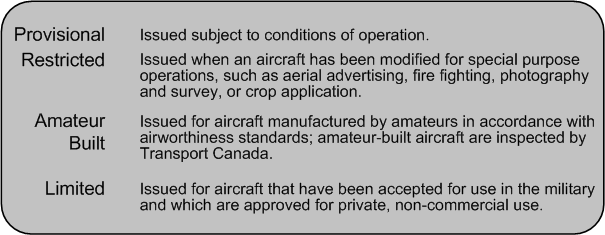
Before an aircraft is issued a Certificate of Airworthiness, the aircraft is subject to inspection in accordance with standards established by Transport Canada.2
There are two types of Flight Permits: those for experimental flight engaged in aeronautical research, and those for specific purpose. Specific Purpose Permits are used for ferry flights of aircraft for repairs or maintenance and for the export and import of aircraft.
Non-airworthiness
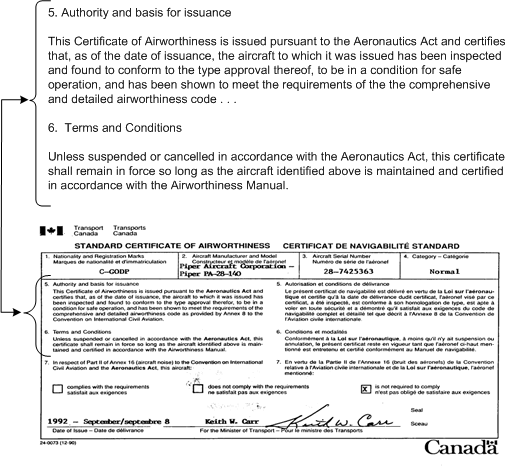
If a pilot flies an aircraft that is not airworthy, he or she is flying in contravention of the law and will be subject to the appropriate consequences. Perhaps more importantly, insurance protection does not cover aircraft operated in a non-airworthy state, and the pilot and operator would therefore be exposed to liability associated with property damage and personal injury.
Certificates of Airworthiness can be invalidated for a number of reasons, the most common being defective equipment. All aircraft defects, irrespective of their effect on the aircraft airworthiness, must be entered in the Journey Log. When faced with a defect, the pilot is responsible to evaluate and determine whether airworthiness is undermined. In this respect, there are two categories of aircraft—those with minimum equipment lists, and those without minimum equipment lists. In the case of the former—aircraft equipped with minimum equipment lists—the actions of the pilot in assessing the airworthy effect of a defect is straightforward—i.e., the minimum equipment list simply specifies what equipment must be functional in a variety of flight operations; if the defective equipment is required, the aircraft is considered operationally not airworthy and the operation cannot be undertaken. By comparison, for aircraft not subject to a minimum equipment list, the general operation equipment requirements specified in the CARs must be consulted. In all cases, defective equipment must be recorded in the Journey Log. If the pilot is unsure of the airworthiness state following detection of a defect, an Aircraft Maintenance Engineer (AME) should be consulted and the Journey Log signed accordingly.
In the case of a commercially operated aircraft, the procedures for the recording of defects in the Journey Log will be specified in the operator’s Maintenance Control Manual, which is essentially a written contract or agreement between the operator and Transport Canada specifying a comprehensive system for ensuring quality control of aircraft maintenance.3
The Maintenance Control Manual further specifies maintenance responsibility of all operational personal. It specifies one person in the operator’s organization that is wholly responsible for system of maintenance—named the Maintenance Manager or Person Responsible for Maintenance—and it specifies the actions that must be taken by line pilots prior to conducting an operational flight—referred to as the rules of technical dispatch.4 Technical dispatch duties include the requirement of the pilot to conduct a pre-flight examination of the operator’s published Aircraft Status Board,5 a pre-flight examination of the Journey Log, a pre-flight inspection of the aircraft, a pre-flight preparation of the takeoff and landing weight and balance, and the completion of pre-takeoff cockpit checks that are specified by the manufacturer.
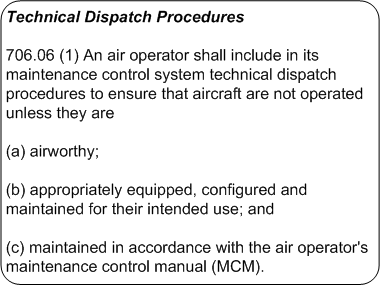
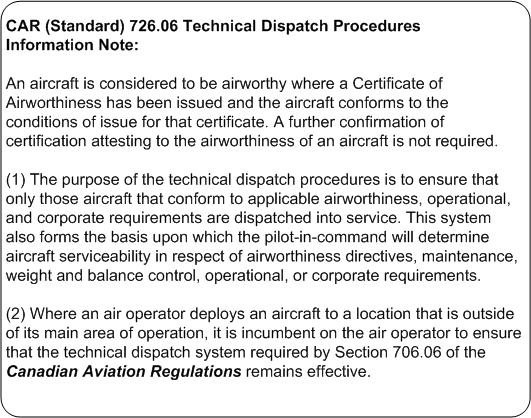
For privately operated aircraft, the Certificate of Airworthiness is invalidated if the aircraft is not maintained as per one of the two accepted schedules of maintenance: the manufacturer’s recommendations, or Transport Canada’s recommendations (Appendix B of CAR 625, entitled the Aircraft Equipment and Maintenance Standard).
If maintained as per the manufacturer’s recommendations, the scheduled maintenance will be described in the aircraft’s maintenance manual, and will often entail inspections for every 50 hours, 100 hours, 200 hours, etc., of air time.
In contrast, when maintained in accordance with Appendix B of CAR 625, private aircraft requires an annual inspection (at least once every 12 months). If an aircraft is flown beyond a scheduled inspection, the Certificate of Airworthiness is not in effect (nor is there insurance protection). The required schedule of maintenance can be determined from an examination of historic entries in the Journey Log.
In the case of commercially operated aircraft, maintenance must be conducted in accordance with operator’s Approved Maintenance Schedule that is specified for each aircraft type in the operator’s fleet—the Approved Maintenance Schedules are typically attached as appendices to the Maintenance Control Manual.
Approved Maintenance Schedules specify two types of maintenance events—in-phase maintenance events, which are associated with airtime cycles, such as 50-hr and 100-hr inspections, for example, and out-of-phase maintenance events that are not related to accumulated airtime, but are instead related to specified calendar dates—e.g., compass swinging (every 12 months), pitot-static system testing (24 months), or the fire extinguisher certification (12 months). Both in-phase and out-of-phase items are listed on a Aircraft Status Board which is consulted by pilots prior to flight operations.
Less obviously, a Certificate of Airworthiness is invalidated if the pilot fails to operate the aircraft in accordance with the Pilot Operating Handbook—i.e., overloads an aircraft, or fails to conduct the required pre-flight inspection.
If a pilot flies an aircraft that is not airworthy, he or she is flying in contravention of the law and will be subject to the appropriate consequences.
Perhaps more importantly, insurance protection does not cover aircraft operated in a non-airworthy state, and the pilot and operator would therefore be exposed to liability associated with property damage and personal injury.
Airworthiness Directives
When Transport Canada becomes aware of service difficulties with particular aircraft it can issue what is described as an Airworthiness Directive (AD); if applicable to air aircraft, an AD established that rectification maintenance that must be undertaken by a time specified by Transport Canada.
ADs are sent out via mail to all registered owners of applicable aircraft; compliance is the legal responsibility of the aircraft owner; non-compliance renders an aircraft non-airworthy.
An AD may apply to particular serial numbers of the aircraft type or the equipment contained on the aircraft (e.g., radios, flight instruments, engines, propellers, seat-belts, etc.).
Proper technical record-keeping is crucial in dealing with ADs as the applicability of an AD can be quickly determined with mere reference to an aircraft’s technical records; attention to the technical records, as well as AD conformance is important when purchasing an aircraft.
AD compliance must be recorded in the Journey Log and transcribed in the technical records.
Service Bulletins
Service Bulletins are published by the aircraft or equipment manufacturer in response to service difficulties; they are not automatically sent to the registered owner; service bulletin compliance is not mandatory, but non-conformity with service bulletins could raise issues for an owner’s safety liability.
Pilot Operating Handbooks
Pilot Operating Handbooks are the manufacturer’s instructions on how to operate and maintain a particular aircraft.
Pilot Operating Handbooks are periodically amended by the manufacturer but the amendments are not automatically forwarded to the registered owner; for this reason an owner should contact the manufacturer regularly (once a year, for example) to determine if any amendments have occurred.
Maintenance Release
According to CAR 605.85, no person shall conduct a takeoff in an aircraft, or permit a takeoff to be conducted in the case of an aircraft owner or operator, following any maintenance (other than elementary work described below) unless a maintenance release entered in the Journey Log has been signed by an AME whereby the following is stated: “The maintenance described above has been performed in accordance with the applicable standards of airworthiness.” A sample maintenance release appears below.
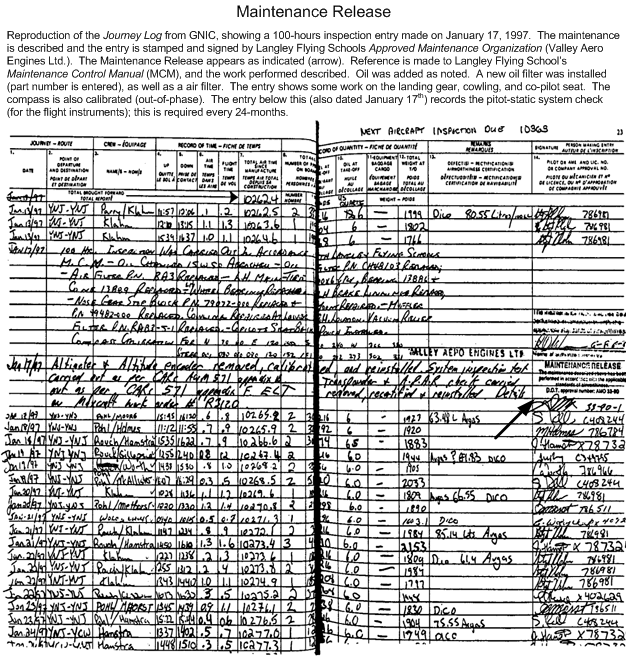
The owner or operator of the aircraft is required to maintain the records of maintenance performed, including the Journey Log and the technical logs. All transcriptions in an aircraft’s technical logs must be completed within 30 days.
Elementary Work—Private Aircraft
While all maintenance activities performed on an aircraft must be, as a rule, undertaken by a qualified AME, there are exceptions to this. Exceptions to this with respect to privately operated aircraft is elementary work performed in accordance with CAR 625.85 (Appendix A [2]), where an AME’s signature is not required. Authorizations for the performance of elementary work is the responsibility of the aircraft owner, and elementary work by a person other than an AME can only be conducted on piston-engine, unpressurized aeroplanes, with less than 12500 lbs. maximum allowable takeoff weight, and not engaged in commercial operations. Elementary work is limited to the following:
- Fabric patches less than 6 inches.
- Replacement of tires, wheels, landing skids or skid shoes, not requiring separation of any hydraulic lines.
- Seasonal reinstallation of skis on fixed landing gear, not requiring separation of any hydraulic lines.
- Replacement of seats, safety belts and harnesses.
- Repair of fairings, non-structural coverplates and cowlings.
- Repair of upholstery and cabin trim.
- Re-installation of glider wings and tail surfaces that are designed for quick assembly.
- Cleaning and installation of spark plugs.
- Checking of cylinder compression.
- Draining and replenishment of oil systems.
- Cleaning or changing of fuel, oil, and air filters.
- Adjustment of generator or alternator drive belt tension.
- Replacement of batteries.
- Checking the electrolyte level and specific gravity of lead acid batteries.
- Replacement of fuses, light bulbs and reflectors.
- Replacement of parts of communications equipment which are line replaceable units designed for rapid replacement.
- Installation of anti-misfuelling devices to reduce the diameter of fuel tank filler openings, when the installation does not involve disassembly of the existing fuel filler opening.
- Independent checking of control systems in accordance with CAR 571.209 (after the control systems maintenance was performed by an AME).
The full details of any of the above maintenance must be entered in the Journey Log and signed by the person performing the work (CAR 571.03).
Elementary Work and Servicing—Commercial Aircraft
With respect to commercial flight operations, approved elementary work is specified in CAR 625.85 (Appendix A [3]). The last authority with respect to the elementary tasks that can be undertaken by operational personal are set out in the company’s Maintenance Control Manual.
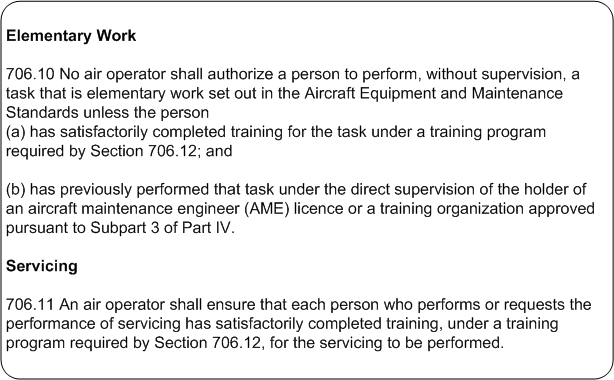
The servicing of commercial aircraft is also tightly controlled and specified by the Maintenance Control Manual. “Servicing” in this regard applies to any “aeronautical product,” and means any “cleaning, lubricating and the replenishment of fluids not requiring the disassembly of the product.”6
References
1 Some aircraft manufacturers publish a Vb speed—design speed for maximum gust intensity.
2 Aircraft with Standard Certificates of Airworthiness are inspected by Transport Canada Inspectors; in the case of amateur-built aircraft, inspections are typically assigned by Transport Canada to designate members of the Experiment Aircraft Association of Canada.
3 Defect rectification and control for commercial operators is specified in CAR 706.05.
4 Regarding Technical Dispatch, see CAR 706.06.
5 The Aircraft Status Board is a required provision of all Maintenance Control Manuals. It is a centralised record of the maintenance status of all aircraft in an operator’s fleet, maintained daily, typically showing the cumulated air time, the air time or date at which the next inspection is due or maintenance tasks are due, and any current defects.
6 The definition of “servicing” appears in CAR 101.01.
.jpg)

